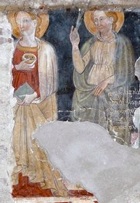

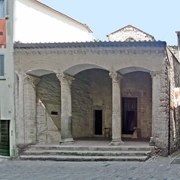
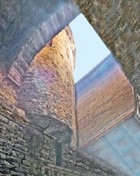
-
✴before the street level was raised, the church could be seen hanging above the the earlier church (8th or 9th century) below it; or
-
✴the church has a pensile (hanging) apse, visible from Vicola delle Torri (as in this photograph).
The present church was probably completed in 1175, the date in an inscription over the portal (see below).
Exterior
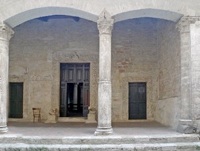
The façade of the upper church, which stands behind the portico of three arches, has three carved portals.
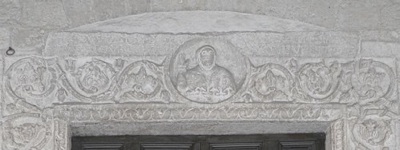
The inscription above the central portal includes the date 1175.
[The architrave on the left has a relief with two eagles. These could reflect the presence in Narni of the Imperial legate, Christian of Mainz, in 1174-6].
Interior
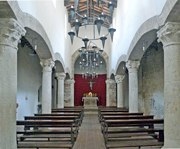
Two colonnades divide the church into a nave and two aisles.
The interior was restored in 2002.
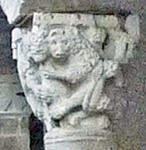
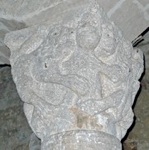
The 3rd column on the right has an interesting capital which has a relief of a man (presumably a Christian martyr) attacked by bears.
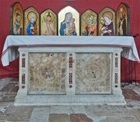

Frescoes (ca. 1400)
The recent restoration revealed a number of interesting frescoes on the right wall, some of which are attributed to:
-
•St Lucy and another female martyr; and
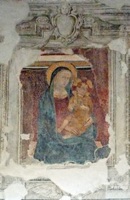
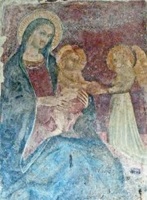
-
•two frescoes of the Madonna and Child, in one of which the baby Jesus reaches towards an angel; and


-
•a damaged fresco of the Madonna and Child with SS Peter Martyr and Ansanus. As is clear from the detail of St Ansanus (kindly sent to me by Signor Giuseppe Fortunati), he holds what is probably a heart and trachea in his left hand, symbolising the manner of his death.
Art from the Church
Processional Banner (ca. 1400)
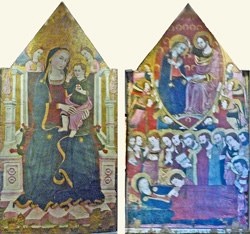
This double-sided panel, which is attributed to the Maestro di Narni del 1409, seems originally to have served served as a processional banner. It was first recorded in 1872 in the sacristy of San Domenico, although this was not necessarily its original location. It could be the banner from Santa Maria Impensole that was used in the annual procession held on the feast of the Assumption of the Virgin.
The panel, which was restored in 1989, depicts:
-
✴ the Madonna and Child enthroned; and
-
✴the Dormition of the Virgin, with her Coronation above.
Lower Church
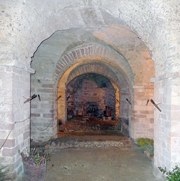
The lower church is reached from a door in the external right wall of the church. If it is locked, a visit can be arranged by Narni Sotterranea. The presbytery of the lower church, which forms the foundations of that of the upper church, is to the right of the entrance. Two colonnades separate the rest of the space into a nave and two aisles.
Two Roman cisterns (1st century BC) can be seen under the floor at the far end.
This earlier church is built above what seems to have been a Roman domus.
